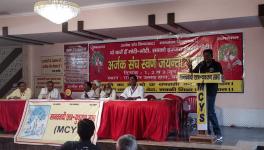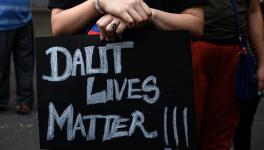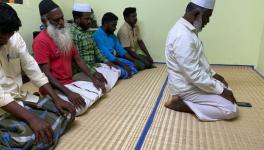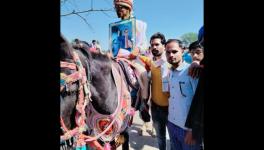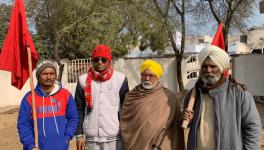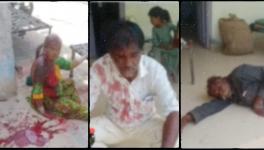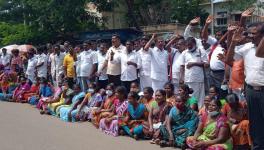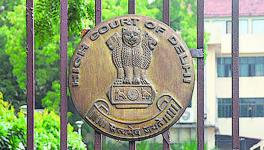A Short Distance Away From Kanpur City: Jai Bhim!
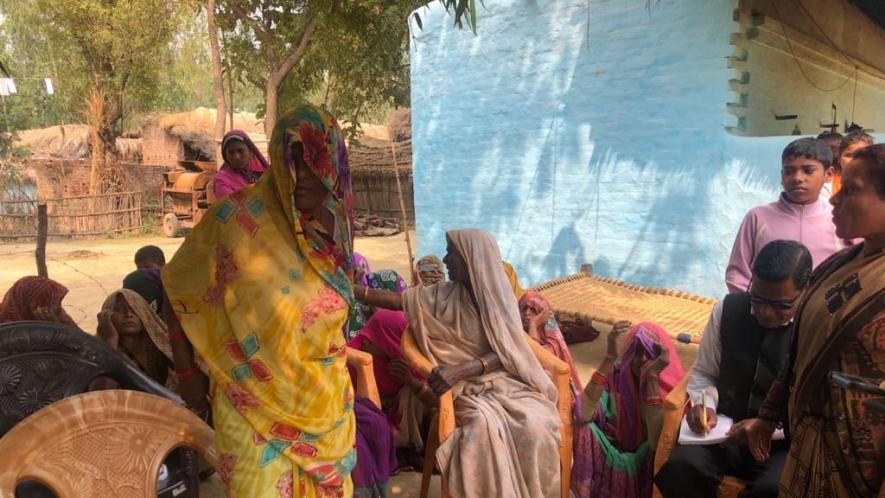
Kanpur Dehat district is just a few kilometres from Kanpur city, with its factories—though many of them are closed—and its malls and urban glitz. Kanpur city can lead people to believe, sometimes, that we have reached the 21st century. Kanpur can also breed the realisation of still being in the 20th century. And it has places which can take us back to the 19th century. But yes, overall, the winds of the 21st century have started blowing in Kanpur.
It is after you leave the city limits and enter the countryside that the previous centuries surround you on all sides. Perhaps this is why citizens in many parts of Kanpur Dehat have been agitating for their areas to be included within Kanpur City limits. And this has even been done for many tehsils. Now, we don’t know if their inclusion has taken them into the 21st century, but we know that those who remain in Kanpur Dehat still await the arrival of the 21st century.
A large part of Kanpur Dehat is still a feudal stronghold. In a considerable area, Dalit residents do not own a single piece of land. Most Dalits used to labour on the lands of others. These ‘others’ were and are the zamindars—the upper caste zamindars, to be precise. Things have changed somewhat now. The landlords have been distancing themselves from farming and are becoming contractors, politicians, government officials, soldiers or army and police officers. They broke away from farming, but are still landowners, so now they give their land to share-croppers. These share-croppers are often relatives of their labourers from the old days.
Remember, since Independence and until a decade ago, a large area of Kanpur Dehat was under the influence of the Arjak Sangh. Certainly, this was the other side of the picture, the converse of the oppressive power of the feudal lords. Members of the Arjak Sangh had campaigned vigorously against Manuwad. They did not accept the supremacy of the upper castes. They were fierce opponents of superstition. As a result, progressive ideas spread in large parts of this area and leaders such as the late Ramswarup Verma continually won Assembly elections here.
However, a lot has changed in recent decades. It is the members of the backward agricultural castes who had come under the progressive influence of the Arjak Sangh, but due to competition—especially political competition—its most ardent supporters started breaking away. Most of them joined other political organisations. Eventually, they became pro-BJP and, as a result, the old domination of the upper caste people and their mentality was once again established.
In this feudal heartland of Kanpur Dehat is a village named Mangata. It is only a short distance from the common road that leads from Kanpur to Jhansi. It is a big village with around 400-500 Dalit families and an equal number of Thakur and Brahmin families. Over recent decades, a new consciousness has also arisen among the Dalits of this area. The old influence of the Arjak Sangh had not been completely erased from among them and after the BSP became powerful, this consciousness started taking new forms. Statues of Dr Bhimrao Ambedkar started being installed in every village. His birth anniversary began to be celebrated with much fanfare on every 14 April. In some places, ‘Ravana Melas’ were also organised.
For the last year or so, some villages started organising a ‘Bhima Katha’. In a Bhima Katha (similar in form to a Satyanarayana katha), Dalit families gather to hear, continuously over a week or ten days, the life stories of Dr Ambedkar and Gautam Buddha. In the end a feast is organised. These narrations are an attempt to end blind faith and familiarise people with the ideology of Buddha and Ambedkar.
So this year a ‘Bhima Katha’ was organised in Mangata village from 1 to 10 February. It was initiated by Bhuyadin-ji of the same village, a very unique personality. Though not well-read, he has a great self-assurance. About him it is said that he does not accept suppression, nor does he tolerate a wrongdoing. He always stands on the side of justice and that is why he is highly respected in the village. Of course, for these very qualities, he also faces opposition. For many years, he has been ploughing the land of a Thakur who has left the village, leaving him fully responsible for the land.
Bhuyadin is a strong opponent of superstition and ritualism. He is always trying to rid people in his village of these ills. When the Bhima Katha started being held in neighbouring villages, he talked of organising one to and engaged the youth in making it happen.
Some people who have built new homes inside the village donated their older land as a site to hold the Bhima Katha. Preparations started from 14 January onward. The ground was levelled to create space and flags were placed all around the spot. A small statue of Buddha was also installed at the site, along with a poster of Dr Ambedkar which listed the 22 conditions he had set for those who seek to convert to Buddhism. And the Bhima Katha took place.
The site of the Katha is very beautiful. Near it, after a slight descent, is a pond visited by many birds, including cranes. It has been prepared with great care and affection. The flags installed at the site still flutter in the air. The statue of Buddha is also in its place. But on 12 February, after the Katha had ended, after the banquet was over too, the poster of Babasaheb was torn.
On the morning of 12 February, a group of Thakur boys reached the scene and tore off Babasaheb poster. The Dalits present there opposed it. There was an argument. The former village pradhan intervened to pacify both sides, convincing the Thakurs to accept their mistake and that assure that nothing like this would happen again. The matter ended there. But only for the Dalits.
It is said that the Thakurs met on the night of 12 February. They had stormy and animated discussions among themselves. Some Thakurs who belong to the village and are in the police, army and so on, were also present, for they had come home to attend a wedding. It may be that their presence served as fuel in the fire...
At around 9 am on 13 February, a mob of 200-300 upper caste boys and men, aged between 15 and 30 years, attacked the Dalits. They had come armed with all kinds of weapons: sticks, axes, sharp-edged agricultural tools. The Dalit men had left to work, so there were only women and children on the Dalit side. When the attackers lit a fire on one end of the village, the women and children ran with buckets of water to extinguish it. That is when they were attacked fiercely.
Thirty to forty women were badly injured and fell senseless after the attack. The attackers then created a ruckus at the government primary school adjacent to the village. After finding out from the teacher, they identified the Dalit children, then dragged them away and beat them mercilessly. They broke five-year-old Adarsh’s hand.
In a while, the police, whom the Dalits had called over the phone, arrived. They started transporting the injured to the hospital. Those who were more severely injured were rushed to Kanpur City Hospital. About 25 of the injured women and girls are here.
Adarsh is also here.
Jyoti is in the hospital in Kanpur. She has 20 stitches on her head. She is doing her BSc and was going to get married in March. It has been postponed. Venus is on the next bed, with injuries on her head and body. Sixty-year-old Bhagyawati is right front of them, a bandage around her head. All the severely-injured are in this hospital. Their relatives and family members are also here. Everyone is talking openly about what was done to them.
The women are badly injured, several young women are like Jyoti, lying in bed with many stitches on their heads. Minor girls like Venus are struggling to cope with the pain of their wounds. But everyone is determined to fight for justice. A new consciousness, a new courage stirs within them. Big leaders are running around, trying to engineer a ‘compromise’ among the residents of Mangata. Some in the administration are also trying to defeat their will to fight. Some of the victims are scared, and in some the resolve is weakening. But it is clear that some of the younger and older women, some boys and girls and the elderly have refused to accept suppression or succumb to fear.
Five-year-old Adarsh is lying on a bed in this hospital. Why was his hand broken? Why was he targeted and attacked? Because that little child used to address everyone with a ‘Jai Bhim’. As soon as he woke up in the morning, his salutation would be heard in the village. On his way to and from school, he would greet whoever he met with a Jai Bhim, uttered with great enthusiasm. He would raise his hand and say—“Jai Bhim”. Even as he lays in his hospital bed now, he slowly raises his hand. He does not get up completely, but he gets up, and from his lips, very soft, you hear his Jai Bhim.
The author is president of All India Democratic Women’s Association and former Member of Parliament from Kanpur.
Get the latest reports & analysis with people's perspective on Protests, movements & deep analytical videos, discussions of the current affairs in your Telegram app. Subscribe to NewsClick's Telegram channel & get Real-Time updates on stories, as they get published on our website.










